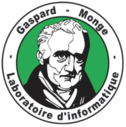PhD Defense Edwin Carlinet
From LRDE
PhD thesis:
Report: carlinet.15.phd.pdf
(Note that this document is in English, except for pages vii to xxiv, in French, which correspond to the mandatory short and long summaries.)
Slides: carlinet.15.phd_slides.pdf
Abstract:
Nowadays, the demand for multi-scale and region-based analysis in many computer vision and pattern recognition applications is obvious. No one would consider a pixel- based approach as a good candidate to solve such problems. To meet this need, the Mathematical Morphology (MM) framework has supplied region-based hierarchical representations of images such as the Tree of Shapes (ToS). The ToS represents the image in terms of a tree of the inclusion of its level-lines. The ToS is thus self-dual and contrast- change invariant which make it well-adapted for high-level image processing. Yet, it is only defined on grayscale images and most attempts to extend it on multivariate images - e.g. by imposing an “arbitrary” total ordering - are not satisfactory. In this dissertation, we present the Multivariate Tree of Shapes (MToS) as a novel approach to extend the grayscale ToS on multivariate images. This representation is a mix of the ToS’s computed marginally on each channel of the image; it aims at merging the marginal shapes in a “sensible” way by preserving the maximum number of inclusion. The method proposed has theoretical foundations expressing the ToS in terms of a topographic map of the curvilinear total variation computed from the image border; which has allowed its extension on multivariate data. In addition, the MToS features similar properties as the grayscale ToS, the most important one being its invariance to any marginal change of contrast and any marginal inversion of contrast (a somewhat “self-duality” in the multidimensional case). As the need for efficient image processing techniques is obvious regarding the larger and larger amount of data to process, we propose an efficient algorithm that can be build the MToS in quasi-linear time w.r.t. the number of pixels and quadratic w.r.t. the number of channels. We also propose tree-based processing algorithms to demonstrate in practice, that the MToS is a versatile, easy-to-use, and efficient structure. Eventually, to validate the soundness of our approach, we propose some experiments testing the robustness of the structure to non-relevant components (e.g. with noise or with low dynamics) and we show that such defaults do not affect the overall structure of the MToS. In addition, we propose many real-case applications using the MToS. Many of them are just a slight modification of methods employing the “regular” ToS and adapted to our new structure. For example, we successfully use the MToS for image filtering, image simplification, image segmentation, image classification and object detection. From these applications, we show that the MToS generally outperforms its ToS-based counterpart, demonstrating the potential of our approach.
Keywords: Tree of Shapes, connected operators, mathematical morphology, level sets, hierarchies, multivariate images, color images.
Composition du Jury :
Président du jury :
- Ludovic MACAIRE (Université Lille 1)
Rapporteurs :
- Coloma BALLESTER (Universitat Pompeu Fabra)
- Philippe SALEMBIER (Universitat Politècnica de Catalunya)
- Ludovic MACAIRE (Université Lille 1)
Examinateurs :
- Jesús ANGULO (Mines ParisTech)
- Pascal MONASSE (École des Ponts ParisTech)
Directeurs de thèse :
- Jean SERRA (ESIEE Paris - Université Paris-Est Marne-la-Vallée)
- Thierry GÉRAUD (EPITA)





